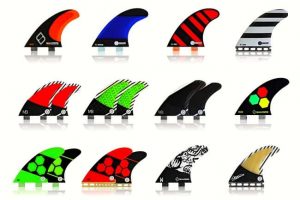Surf fins and why they are important for a surfboard.
Surf fins have a double function. On one hand, they maintain the front of the surfboard on a frontward course and they avoid the tail from drifting when making a turn. Gives push, resistance, more feeling and control when making turns and lines. But the question is, how many surf fins do I use on my surfboard?
We have different options: single fins, twin fins, trifins, quad fins and five fins. Next we´ll explain what each one is trying to do. A good fin system is proportional to the width of the tail and the volume of the board.
No fins
The first boards made by Polynesians didn´t have fins, but they weren´t worried about making complicated maneuvers or turns. If you´ve never surfed without fins, we recommend you try it. It will make you have to kneel more and lower your center of gravity, something that will improve your surfing. Here´s a video that will show you the difference between surfing with fins and without fins.
Single fins
As the name indicates, there is only one central fin. A surfboard that was very present in the 70s and is associated with the “old-school”. It isn´t the configuration that will most help you to make maneuvers and tricks, but will help you with your paddling and offer optimal velocity. Works well with big waves and will give you good performance. This week we have a good video with Single Fin, because surfing with one fin is a whole experience.
In our online store we have a special section dedicated towards Single Fins.
Twin fins
Created in the 30s-40s they are also viewed as “old-school”. With these configurations you will gain speed but lose adherence when turning. Your maneuvers will be more closed and your stability will improve, but bigger waves could transmit certain instability.
In our surfboard section you can find our opinion on the different Twin Fins that our team of testers has been able to get their hands on. Such is the case with the Modern Twin Fin by Clayton and the Ono Fish from Single Quiver Surfboards.
Tri fins
Without a doubt, the most used configuration. Created by the surfer Simon Anderson in 1980 with the name Thruster. Simon showed a year later its efficacy by winning the Bells, Surfabout and Pipeline trials. The Australian shaper got no less than 4 titles with the tri fin novelty. Check out his catalogue of boards in Single Quiver.
That third fin gives it more speed to the boards and helps maneuvers. A perfect mix between precision of the single fin and the speed of the twin fins. Ideal for most radical of maneuvers and big waves. On the other hand, because of its speed and hold it isn´t the best configuration for tubes.
Quad fins
With Kelly Slater as ambassador, this configuration offers more adherence and acceleration power. Faster and with good functionality in tubes, they´re most used in world circuit trials like Pipeline. A good choice for big waves, since the enormous quantity of water that flow between the fins gives more stability to the surfer. Kelly Slater uses them in both small waves and big waves. But we already knew Kelly is from another galaxy.
Five fins
This is the Quad configuration but with the added stabilizer in the center. The Quads already gave us more adherence and with this small central fin we stabilize the tail in the most critical sections and the most vertical parts without taking away speed. This way we maintain control when doing radical turns.
And what configuration do you prefer? 1, 2, 3, 4, 5 or do you dare to surf without fins?
If you liked this post we encourage you to visit our tag #surfbase where we will show you different articles and posts. Pleases subscribe to our newsletter to get the latest and exclusive offers.
Follow us on Youtube:
https://www.youtube.com/c/EnelpicoSingleQuiver
Follow us on Facebook:
https://www.facebook.com/enelpico/
Follow us on Instagram:






